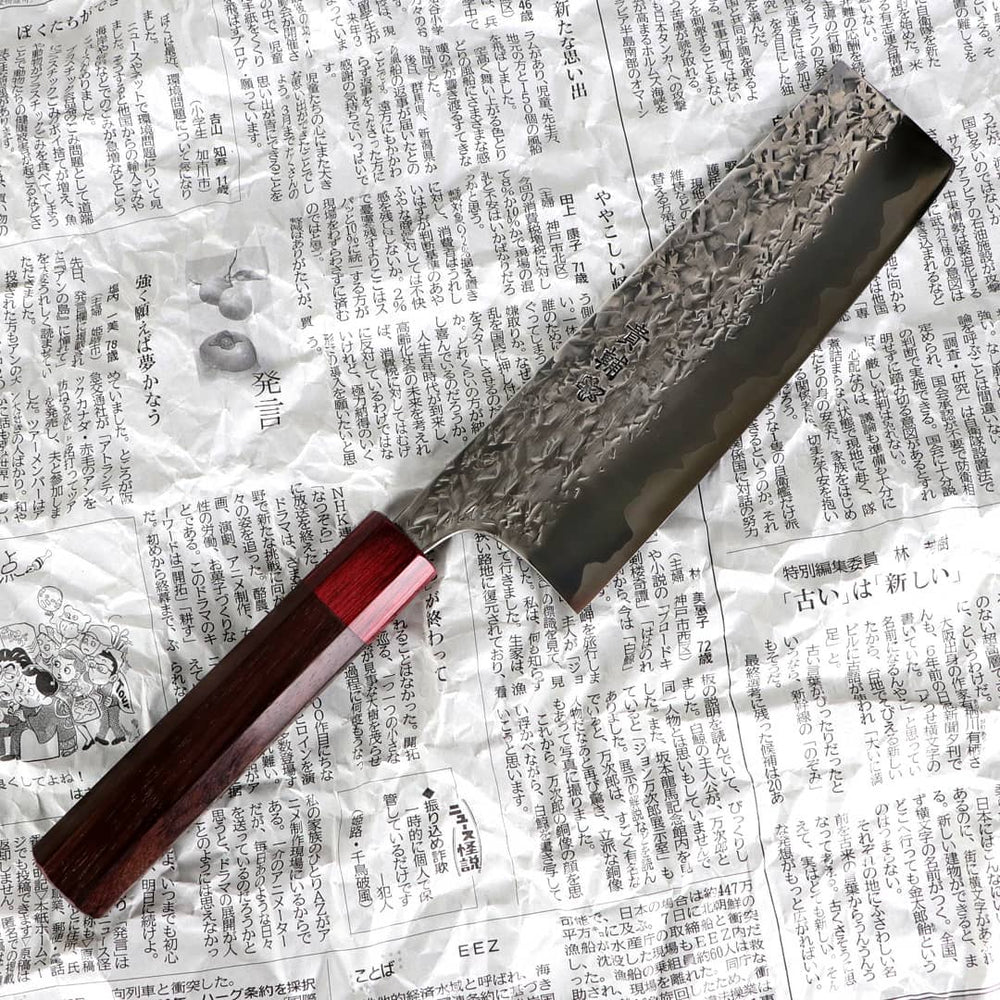The Main Types of Japanese Knives
If you want to buy your first Japanese knife, you often can't see the forest for the trees. With all the different blade shapes, steels, forges, handle materials and surface structures, you don't know what you actually need and want. We know this and therefore provide you with the most important information summarized in a few lines. Read this article and you will realize that the world of Japanese knives is very diverse, but actually not as complicated as you might think at first.

The blade shape - All-Rounder or Specialist?
Basically, the blade shapes of Japanese knives can be divided into two main groups: All-purpose knives and specialist knives.
An all-purpose knife belongs in every kitchen and as the name suggests, most foods such as fish, meat and vegetables can be cut with this knife. Japanese all-purpose knives include the Santoku knife, Bunka knife and Gyuto knife types. The blades of general purpose knives are usually 160 to 240mm long. The gyuto has a tapered blade - this type of knife is very similar to the Western chef's knife. The eye-catching tip of the Bunka knife can be very useful when removing tendons or skins from cuts of meat. The Santoku, popular all over the world, offers enough space for the fingers under the handle due to its wide blade and can therefore be wielded very safely and precisely.
There is a great variety in the special forms of Japanese knives. Whether you are a fish cook, a vegetable specialist or a sushi professional - depending on where your focus lies in the kitchen, you will find the right type of blade in the world of Japanese chef's knives, making the preparation of your favorite dishes a pure joy.
Usuba and Nakiri knives are used as vegetable knives in Japan. These special knives are ideal for chopping vegetables and finely chopping herbs thanks to their thin blades and almost rectangular forged blades. After cutting, the food can be easily "scooped" into a pot or pan with the Nakiri knife.
For fish fans, the Funayuki knife can be an interesting choice. Funayuki knives are the traditionally used blades of Japanese fishermen, today they are often used as general purpose knives. In the past, Japanese fishermen always had their Funayuki with them on the boat to gut the catch and portion it directly if necessary. With blade lengths of around 180mm, a tapered blade and a blade of average thickness, fishermen were well equipped with this blade for all the work that had to be done directly on the boat. Even today, these blades are still forged and are still widely used.
The Japanese Kiritsuke knife is also excellent for handling fish. Typical for the Kiritsuke are blade lengths from 200mm. Characteristic are also the elaborated tip and the cutting edge running parallel to the back of the blade. The Kiritsuke can be used not only to cut fish but also vegetables.
Another special form of Japanese blades is the Honesuki knife - this type of blade is ideal for boning poultry. Poultry joints can be easily cut (not chopped!) with this type of knife. With the narrow and rather compact (approx. 150mm blade length) Honesuki blades you can cut along the bone in the best way to loosen the meat.
Widely used and also very popular in Europe are the Japanese Petty Knives. They can be used as smaller all-purpose knives (blade length from 75mm) and are absolutely recommendable as a supplement to a somewhat larger Japanese all-purpose knife. With the Petty, more delicate work such as peeling fruit can be done perfectly, a large all-purpose knife would not be handy enough for this.
An absolute classic in the world of Japanese knives is the Deba knife (Deba Hocho). It is mainly used for cutting fish and meat. It is often referred to as a cleaver, but it is important to know that it is not used in a striking manner. Instead, you place the blade on the piece to be cut and then apply pressure to the back of the blade, which is up to 6mm thick, to guide the blade of the Deba knife through your foods with pressure.
An all-purpose knife belongs in every kitchen and as the name suggests, most foods such as fish, meat and vegetables can be cut with this knife. Japanese all-purpose knives include the Santoku knife, Bunka knife and Gyuto knife types. The blades of general purpose knives are usually 160 to 240mm long. The gyuto has a tapered blade - this type of knife is very similar to the Western chef's knife. The eye-catching tip of the Bunka knife can be very useful when removing tendons or skins from cuts of meat. The Santoku, popular all over the world, offers enough space for the fingers under the handle due to its wide blade and can therefore be wielded very safely and precisely.
There is a great variety in the special forms of Japanese knives. Whether you are a fish cook, a vegetable specialist or a sushi professional - depending on where your focus lies in the kitchen, you will find the right type of blade in the world of Japanese chef's knives, making the preparation of your favorite dishes a pure joy.
Usuba and Nakiri knives are used as vegetable knives in Japan. These special knives are ideal for chopping vegetables and finely chopping herbs thanks to their thin blades and almost rectangular forged blades. After cutting, the food can be easily "scooped" into a pot or pan with the Nakiri knife.
For fish fans, the Funayuki knife can be an interesting choice. Funayuki knives are the traditionally used blades of Japanese fishermen, today they are often used as general purpose knives. In the past, Japanese fishermen always had their Funayuki with them on the boat to gut the catch and portion it directly if necessary. With blade lengths of around 180mm, a tapered blade and a blade of average thickness, fishermen were well equipped with this blade for all the work that had to be done directly on the boat. Even today, these blades are still forged and are still widely used.
The Japanese Kiritsuke knife is also excellent for handling fish. Typical for the Kiritsuke are blade lengths from 200mm. Characteristic are also the elaborated tip and the cutting edge running parallel to the back of the blade. The Kiritsuke can be used not only to cut fish but also vegetables.
Another special form of Japanese blades is the Honesuki knife - this type of blade is ideal for boning poultry. Poultry joints can be easily cut (not chopped!) with this type of knife. With the narrow and rather compact (approx. 150mm blade length) Honesuki blades you can cut along the bone in the best way to loosen the meat.
Widely used and also very popular in Europe are the Japanese Petty Knives. They can be used as smaller all-purpose knives (blade length from 75mm) and are absolutely recommendable as a supplement to a somewhat larger Japanese all-purpose knife. With the Petty, more delicate work such as peeling fruit can be done perfectly, a large all-purpose knife would not be handy enough for this.
An absolute classic in the world of Japanese knives is the Deba knife (Deba Hocho). It is mainly used for cutting fish and meat. It is often referred to as a cleaver, but it is important to know that it is not used in a striking manner. Instead, you place the blade on the piece to be cut and then apply pressure to the back of the blade, which is up to 6mm thick, to guide the blade of the Deba knife through your foods with pressure.
Anyone who likes to prepare Sashimi and Sushi will be delighted with a Japanese Yanagiba knife. This type of knife was developed precisely for this purpose. With the relatively long, thin-bladed Yanagiba knives, raw fish can be perfectly processed into Sashimi, and Yanagibas (other names: Tako hiki, Fugu hiki, Sashimi bocho) are also used for the preparation of other seafood.
If you want to portion fish and meat or cut very fine slices of meat, for example to prepare Ham, Carpaccio or Vitello Tonnato, it is best to use the Japanese Sujihiki knife. This fine carving knife can be guided very precisely, so that the necessary fine cuts are sure to succeed. The typical blade length of a Sujihiki knife starts at about 200mm and goes up to over 300mm.
As you can see, the world of Japanese knives is a wide field, but ultimately it can be broken down to a few simple points: A general purpose knife is essential - here you can go for Bunka knives, Santoku knives or Gyuto knives. If you also frequently prepare special dishes, then you can supplement your knife collection with the appropriate blade - for example, if you're a sushi friend, you'll want to get a Yanagiba knife. If you're often processing large quantities of vegetables, you should consider a Nakiri knife in addition to your all-purpose knife.
If you know exactly which knives should be in your own collection, you can also be happy with a Japanese knife set from our store. A Japanese knife set from our store offers a price advantage. We offer a variety of different knife sets for various preferences of our customers. If you want to compose your individual Japanese knife set, please feel free to contact us by email.
If you want to portion fish and meat or cut very fine slices of meat, for example to prepare Ham, Carpaccio or Vitello Tonnato, it is best to use the Japanese Sujihiki knife. This fine carving knife can be guided very precisely, so that the necessary fine cuts are sure to succeed. The typical blade length of a Sujihiki knife starts at about 200mm and goes up to over 300mm.
As you can see, the world of Japanese knives is a wide field, but ultimately it can be broken down to a few simple points: A general purpose knife is essential - here you can go for Bunka knives, Santoku knives or Gyuto knives. If you also frequently prepare special dishes, then you can supplement your knife collection with the appropriate blade - for example, if you're a sushi friend, you'll want to get a Yanagiba knife. If you're often processing large quantities of vegetables, you should consider a Nakiri knife in addition to your all-purpose knife.
If you know exactly which knives should be in your own collection, you can also be happy with a Japanese knife set from our store. A Japanese knife set from our store offers a price advantage. We offer a variety of different knife sets for various preferences of our customers. If you want to compose your individual Japanese knife set, please feel free to contact us by email.
The surfaces of Japanese blades - not only a question of appearance
Japanese knives differ not only in terms of their blade shapes - the surface treatment of the blades also differs greatly. The simplest and most familiar variant is a polished blade without any further structure on the blade. This blade finish is the classic and widely used. We offer numerous variants of such Japanese knives - for example from the Yoshimitsu forge, from the Misuzu forge or from the Silverback Knives series.
A more special variant is the Kurouchi finish. This dark blade surface is produced by carbonization. In addition to the attractive appearance of these blades, the Kurouchi finish improves the durability and corrosion resistance of the sheath steel. So in addition to aesthetics, the Kurouchi finish definitely has a functional benefit. We carry Kurouchi blades from Japanese master forges Ishikawa, Matsubara and Kisuke.
A more special variant is the Kurouchi finish. This dark blade surface is produced by carbonization. In addition to the attractive appearance of these blades, the Kurouchi finish improves the durability and corrosion resistance of the sheath steel. So in addition to aesthetics, the Kurouchi finish definitely has a functional benefit. We carry Kurouchi blades from Japanese master forges Ishikawa, Matsubara and Kisuke.

One disadvantage of smooth polished blades is certainly the sticking of the cut food. Who hasn't experienced it - slices of cucumber pile up the blade as you slice, and eventually the tower collapses. That's because moist food sticks to the very smooth blades, so it won't come off the blade on its own. For Japanese knives, there are surface structures that prevent exactly this effect. For example, blades with a Nashiji finish are not polished. Instead, the blade is given a certain roughness that prevents food from sticking and, at the same time, is appreciated by many customers because of its appearance.
Knife blades with a Tsuchime finish, on the other hand, are hammered to create elaborate patterns on the blade. These patterns not only look good, but also have the effect of creating air pockets between the sliced food and the blade surface, preventing the food from sticking. To stay with the cucumber example: With a Tsuchime blade, every single slice of cucumber will fall off the blade immediately after being cut. We carry Tsuchime blades in the Kisuke Series, the Matsubara Series and the Silverback Series.
Knife blades with a Tsuchime finish, on the other hand, are hammered to create elaborate patterns on the blade. These patterns not only look good, but also have the effect of creating air pockets between the sliced food and the blade surface, preventing the food from sticking. To stay with the cucumber example: With a Tsuchime blade, every single slice of cucumber will fall off the blade immediately after being cut. We carry Tsuchime blades in the Kisuke Series, the Matsubara Series and the Silverback Series.



